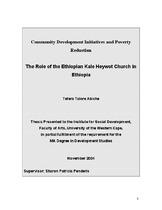| dc.description.abstract | Ethiopia is a country well endowed with a number of development related NGOs who have been involved in socio-economic development at national, regional and grassroots level. In a country like Ethiopia, where natural and man-made hazards persist, NGOs play a crucial role in terms of reducing poverty and other human sufferings. As one of the non-governmental organizations, the Ethiopian Kale Heywot Church Development Program (EKHCDP) has played an important role in supporting and encouraging the development aspirations of local communities in the areas of environmental rehabilitation, water and sanitation, agriculture, health, education, credit and saving schemes.The study focused on the Ethiopian Kale Heywot Church community development program in five selected project areas, namely Lambuda, Durame, Shashamane, Debraziet and Nazret. The analysis subsequently examined the nature and extent of community participation in the project planning, implementation and decision-making phases. Thereafter, the study brought into focus general observations gleaned from the investigation and provides recommendation to the EKHC and other stakeholders that have been involved in development activities. Quantitative and qualitative methods of research have been applied throughout the investigation. Accordingly, observation, in depth interviews, focus group discussions and structured and semi-structured questionnaires were used to gather information. The qualitative mode was employed to gather socially dynamic information on issues relating to beneficiaries’ perceptions of processes in order to gain a deeper understanding of the dynamics at play. On the other hand, the quantitative mode was used to test variables related to the research problem. The findings indicate that the Ethiopian Kale Heywot Church development program has played a significant role in terms of community development. Moreover, its development approach is responsive to local needs and able to mobilize local and external resources to support the poor, so that through empowerment and participation they will be released from the deprivation trap that they find themselves in. The study also indicates that the EKHCDP has good linkages and networks with other communities and partners. However, the study indicated that the intensity of community participation in decision-making is still low in certain cases. Meanwhile, the beneficiaries did not show a clear understanding of aspects such as project ownership. Finally, this study recommends that genuine community participation should be maintained because it is the core activity contributing to beneficiary empowerment and grassroots institutional capacity building and an essential ingredient for self-reliance and project sustainability. | en_US |

